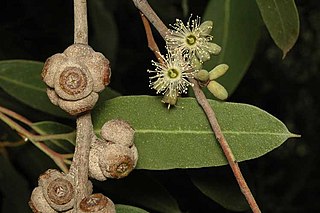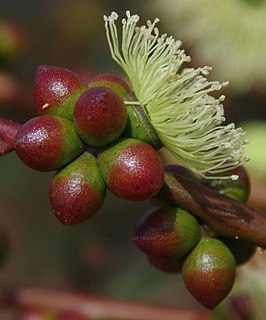
Eucalyptus ligustrina, commonly known as the privet-leaved stringybark, is a species of shrub, mallee or small tree that is endemic to New South Wales. It has rough, stringy bark, lance-shaped to egg-shaped adult leaves, flower buds in groups of between seven and fifteen, white flowers and hemispherical or shortened spherical fruit.

Eucalyptus tenella, commonly known as narrow-leaved stringybark, is a species of small to medium-sized tree that is endemic to New South Wales. It has stringy bark, narrow lance-shaped to linear leaves, flower buds in group of seven to fifteen, white flowers and hemispherical fruit.

Eucalyptus serraensis, commonly known as the Grampians stringybark, is a species of small tree or mallee that is endemic to the Grampians in Victoria, Australia. It has rough, stringy, fibrous or flaky bark on the trunk and sometimes also the branches, smooth bark above, lance-shaped to egg-shaped or round adult leaves, sessile flower buds in groups of three or seven, white flowers and hemispherical or cup-shaped fruit.
Eucalyptus × conjuncta is a species of flowering plant that is endemic to a small area of New South Wales. It is a tree with rough stringy bark, lance-shaped adult leaves, flower buds in groups of eleven or more, white flowers and cup-shaped or hemispherical fruit. It is considered to be a stabilised hybrid between E. eugenioides and E. sparsifolia.

Eucalyptus bensonii, commonly known as Benson's stringybark, is a small tree or mallee that is endemic to New South Wales. It has rough grey or brown stringy bark on the trunk and larger branches, smooth bark on the thinnest branches, broadly lance-shaped to egg-shaped adult leaves, flower buds arranged in groups of seven, nine or eleven, white flowers and cup-shaped or hemispherical fruit in clusters.

Eucalyptus boliviana, commonly known as Bolivia Hill stringybark or Bolivia stringybark is a shrub or a mallee, sometimes a small tree and is endemic to a small area in northern New South Wales. It is a stringybark with four-sides stems, broadly lance-shaped adult leaves, flower buds arranged in groups of seven, yellow flowers and hemispherical to broadly funnel-shaped fruit.
Eucalyptus retinens, commonly known as Hillgrove box, is a species of tree that is endemic to the Northern Tablelands of New South Wales. It has rough, fibrous or flaky bark on the trunk and larger branches, smooth bark on the thinner branches, lance-shaped adult leaves, flower buds in groups of seven, white flowers and cup-shaped, cylindrical or hemispherical fruit.

Eucalyptus aspratilis, commonly known as the soak yate or inland mallee-yate, is a mallee that is endemic to Western Australia. It has rough bark near its base, smooth silvery greyish bark above, lance-shaped adult leaves, pendulous buds in groups of seven, pale yellow or cream-coloured flowers and cylindrical fruit.
Eucalyptus blaxellii, commonly known as the Howatharra mallee, is a mallee that is endemic to Western Australia. It has smooth bark, linear to narrow lance-shaped adult leaves, flower buds arranged in groups of seven, white flowers and cup-shaped to conical fruit.

Eucalyptus effusa, commonly known as rough-barked gimlet, is a species of mallee or small tree that is endemic to Western Australia. It has thin, rough bark on the base of the trunk, smooth bark above, linear to narrow lance-shaped adult leaves, flower buds arranged in groups of seven, white flowers and cup-shaped to conical fruit.
Eucalyptus laevis is a species of mallee or tree that is endemic to Western Australia. It has thin, rough, fibrous or flaky bark on the trunk, smooth bark above. Its adult leaves are linear to narrow lance-shaped, the flower buds are arranged in groups of between seven and eleven, the flowers are white and the fruit is cylindrical to barrel-shaped.

Eucalyptus leptocalyx, commonly known as Hopetoun mallee, is a species of mallee that is endemic to an area along the south coast of Western Australia. It has smooth bark, lance-shaped adult leaves, flower buds in groups of between nine and fifteen, creamy white flowers and barrel-shaped to cylindrical fruit.
Eucalyptus luculenta is a species of mallee that is endemic to a small area on the south coast of Western Australia. It has smooth bark, lance-shaped to egg-shaped leaves, flower buds in groups of seven, pale yellow to white flowers and cup-shaped, barrel-shaped or cylindrical fruit.
Eucalyptus protensa is a species of mallee that is endemic to the southwest of Western Australia. It has smooth, dark grey or brownish bark, narrow lance-shaped adult leaves, elongated flower buds in groups of seven, yellowish green flowers and hemispherical fruit.

Eucalyptus bakeri, commonly known as Baker's mallee or the mallee box, is a eucalypt that is endemic to eastern Australia. It has fibrous bark on the trunk and smooth white or grey bark above, narrow lance-shaped leaves, flower buds in groups of between seven and thirteen, white flowers and hemispherical or shortened spherical fruit.

Eucalyptus cylindriflora, commonly known as the white mallee, is a species of mallee that is endemic to the southwest of Western Australia. It has smooth bark, glossy green, linear adult leaves, flower buds in groups of seven, creamy white flowers and cylindrical to cup-shaped fruit.

Eucalyptus cylindrocarpa, commonly known as the woodline mallee, is a species of mallee that is endemic to Western Australia. It has mostly smooth bark, sometimes with loose fibrous or flaky bark near the base of the trunk, linear to lance-shaped or curved adult leaves, flower buds in groups of seven, nine or eleven and cylindrical to barrel-shaped fruit.
Eucalyptus foliosa is a species of mallee that is endemic to Western Australia. It has a dense crown with foliage reaching to the ground, smooth greyish bark, linear to narrow lance-shaped or narrow oblong adult leaves, flower buds in groups of seven or nine, white flowers and conical to shortened hemispherical fruit. It is only known from a small area near Esperance.

Eucalyptus terebra, commonly known as Balladonia gimlet, is a species of gimlet that is endemic to Western Australia. It has satiny or glossy bark on its fluted trunk, linear to narrow lance-shaped adult leaves, flower buds in groups of seven, yellowish flowers and conical to hemispherical fruit. It is one of the seven species of gimlet.
Eucalyptus × balanopelex is a mallee that is endemic to a small area of the south-west of Western Australia. It has smooth bark, broadly lance-shaped adult leaves, flower buds in groups of seven, creamy-white flowers and hemispherical fruit. It is thought to be a hybrid between E. kessellii subsp. eugnosta and E. semiglobosa.











